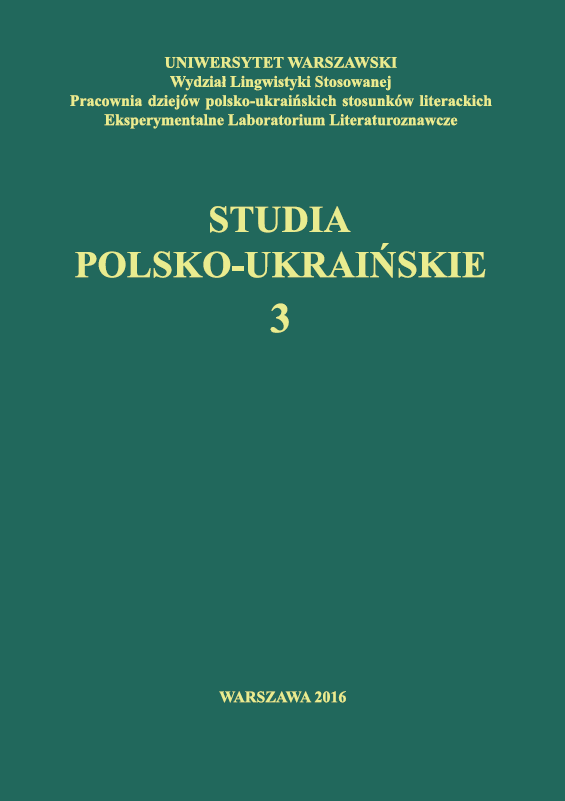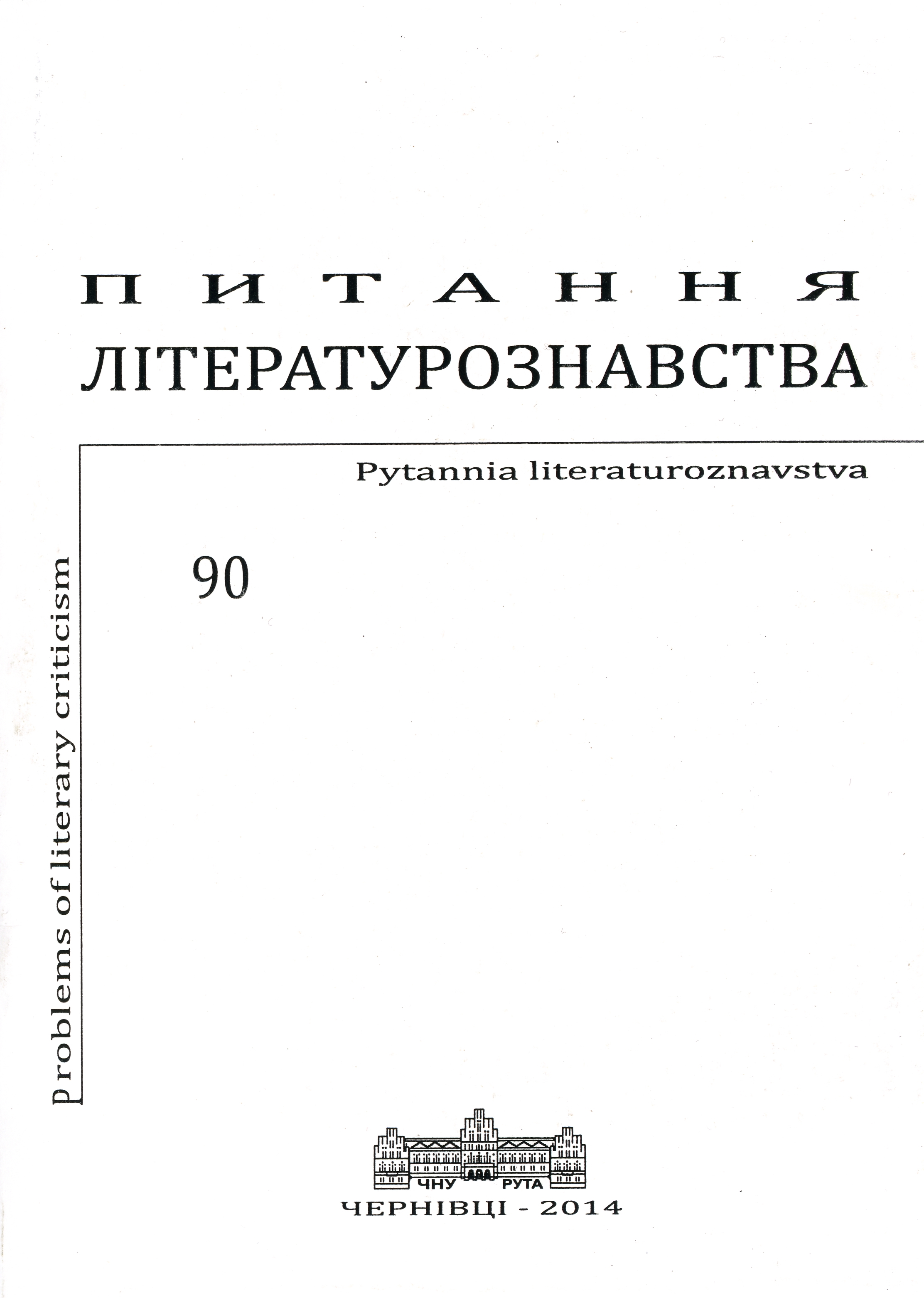
We kindly inform you that, as long as the subject affiliation of our 300.000+ articles is in progress, you might get unsufficient or no results on your third level or second level search. In this case, please broaden your search criteria.



The author discusses Ivan Franko’s poem Moses, regarded by Yurii Sherekh as the „Second Testament” of Ukrainian literature. This positive opinion of the Moses stimulates research interests. Using the methods of comparative contextual hermeneutics, the author analyses Ivan Franko’s specific “theology of hope” in the historical literary and philosophical theological context. He argues that the basis for hope in Franko’s philosophical reflection upon history was the Old Testament eschatology, born from God’s covenant with Israel and from the faith in a liberating-salvation mission of Moses. He draws special attention to the prophetic meaning of the Prologue and the poet’s references to the figure of Moses.
More...
Mykhailo Hrushevsky, a Ukrainian historian and politician, was born at Chełm on 29 September 1866, died on 25 November 1934 at Kislovodsk. He is the author of a ten-volume synthesis of History of Ukraine-Rus’, published in Lwow and Kiev in 1898–1936. In his work, he separated the history of Ukraine from the history of Russia. Living and working in specific national and social conditions of Ukraine at the turn of the 20th century, he disapproved of the role of Poland and Polish people in the history of Ukraine. The response of the Polish historiography of that time to Hrushevsky’s work was very negative – he was accused of having politicised history. Those opinions and polemics concerning Hrushevsky and his publication have been gathered and presented in a book by Ł. Adamski Nacjonalizm postępowy. Mychajło Hruszewski i jego poglądy na Polskę i Polaków [Progressive Nationalism. Mykhailo Hrushevsky and His Opinions of Poland and Poles], published in Warsaw in 2011. There is also a debate among Ukrainian historians. Since 1997 the History of Ukraine-Rus’ is being published in English (The Hrushevsky Translation Project), thanks to The Peter Jacyk Centre for Ukrainian Historical Research Canadian Institute of Ukrainian Studies. The project is headed by Professor Frank E. Sysyn. The last, tenth volume, is entitled: From the Death of Khmelnytsky to the Union of Hadiach (Edmonton–Toronto 2014). The English edition is supplemented with a full and comprehensive critical apparatus and rich literature on the subject.
More...
The article deals with the novel “The rose ritual of pain” by Stepan Protsyuk. This novel is examined as metaphysical model of the biography of artist. The metaphysical of Stepan Protsyuk’s fiction is primarily manifested by the existential states, when the person opens the “supersensual”, “divine being”. Consequently, the main points of metaphysical model of artist’s biografy features the existential states of Stefanyk’s life in it’s most intense moments. The depth of Stefanyk’s psychology is closely connected to the transcendental sphere that forms the metaphysical horizon of the novel. The basics of metaphysics forms the philosophical plane of the novel. So the problem that we research has to do more specifically with the philosophical expression. Philosophical and aesthetic approach to text analysis involves the use hermeneutical, comparative research methods. The spiritual concepts (emotional experience, solitude, creative imagination and others) are studied regarding the metaphysical nature of human being. The studying of novel “The rose ritual of pain” according to the metaphysical philosophy makes clear the Stefanyk’s creative phenomenon and the creative process in general. The article supplements the theoretical information about the art and biographical prose, explicates the new means of Ukrainian literature study according to the interdisciplinary research.
More...
This article is about a the world picture and a man in it, which appears in the recipient imagination under the influence of O. Honchar’s diary. The question of writer’s life and creativity is considered. Diariush is interpreted as a kind of autobiographical genre. It is said that the daily fixing manifestations of life determines author dual role / narrator: he confesses himself and shows what is happening around him and with others. Special relationship between addressee (narrator) – the recipient (beneficiary): on the one hand, the receiver (beneficiere) – it is the sender itself, and the second – the future recipient, are examined. The specific structure of the text is characterized. The forms and ways of expressing paradigmatic relations own / other are defined. It is confirmed that human concept in O. Honchar is formed by not only direct but indirect way. It is given the list of details such as self-consciousness of mankind, man ... realized his mission, was the spiritual became …force of life...The techniques of literary skills to create portraits that make up the gallery of real characters of the epoch (writers, scientists, politicians, peasants, soldiers, and others) are revealed. It is emphasized that Honchar’s notes about Holodomor (famine) and other forbidden topics first, pay attention to the different views of their vision; second, these notes in the subtext hidden forced silence which shows typological situation of many artists. It is proved that in O. Honchar’s diaries writer biography is both a biography of a generation that preceded the sixties and biography of Ukrainian creative intelligentsia.
More...
The article presents the opinions about Mykhailo Hrushevsky’s life and work presented in the Polish historical and journalistic literature of the late 19th and early 20th century. Two periods in the development of Polish Hrushevskiana have been determined. The first one (the second half of the 1890s) is represented by a generally objective and scientific approach – specific research issues were actualised at that time, and a discussion that took place at the time was steered in the direction of finding the most appropriate solutions to the problem. The next one (the beginning of the 20th century) brought about a significant radicalization of the Ukrainian and Polish national movements, and hence the aggravation of Polish-Ukrainian relations, which was reflected in the nature of the historiographical debates towards their politicisation. The basic characteristics and trends of the Polish Hrushevskiana have been revealed. The total dependence on historiographical assessments of the changed political landscape had been specified. It is concluded that Hrushevsky’s historiographical concepts in Polish historians’ interpretations embodied the conceptual basis of entire Ukrainian Clio. The process of politicisation of the Ukrainian-Polish historiographical debate at the beginning of the 20th century, to the aggravation to which the both parties have contributed, reflected a general tension in the relations between the neighbouring nations on the eve of the Great War. The revival of the dialogue of the previous period and its transformation into a monologue focused entirely on the collecting of national grievances brought about significant difficulties in seeking the international understanding during the war and after the emergence of the Second Polish Republic.
More...
The present article analyses the lyric and epic poetry of Lesya Ukrainka. Emphasis is put on the fact that all the works of the poet reveal her epic talent, but that the transition to lyric and epic, with the introduction of dramatic moments, and dialogues, gave the poems a tragic, dramatic perception of the world with a clear lyrical colour. The ideas of asceticism, sacrifice for the humankind and the establishment of justice, love of country is defined as one of the leading characteristics of Lesia Ukrainka. It is concluded that the poet was constantly in the international sphere, as she called for justice, brotherhood, freedom – as the highest ideals of peaceful coexistence of nations.
More...
The article deals with a stereotypical perception of Lesya Ukrainka drama Blue Rose as an experimental and somewhat incomplete work. The main thesis of the text is: the drama fits into the context of European dramaturgy of the late 19th – early 20th century and is consonant with the aesthetic searches of symbolists. The author analyses the motive of hereditary insanity, psychology drama, including fears of the protagonist, autobiography of work, and makes a comparison between interpretations of love themes in Lesya Ukrainka and Dante, and in Lesya Ukrainka and Russian symbolists (A. Blok, A. Bely). The basis for drama philosophy of two worlds was made through the establishment of platonic love doomed to end in tragedy in an imperfect world. The activation of a Middle Ages discourse allowed Lesya Ukrainka to do all the artistic discoveries, which later become the basis for the formation of symbolist theatre.
More...
The article presents the relationship between the drama of Larysa Kosach (Lesya Ukrainka) and philosophy of Friedrich Nietzsche. This connection is to show the crisis of Christian philosophy, which European culture faced at the turn of the 20th century. One of the significant roles was played by the Paul the Apostle, who often appears in Lesya Ukrainka’s drama and is the reason for polemics with the New Testament’s vision of the religion, the concept of the state and social order. The similarity with Nietzsche’s philosophy here is striking, because in both cases the “Good News” of the Saint of Tarsus is interpreted not only in opposition to the teachings of Christ, but first and foremost as the factor in early Christianity, which contributed to strengthening Christian morality consistently controverted by Nietzsche and Lesya Ukrainka.
More...
The author describes numerous bans placed on the literature and culture of Ukrainian Baroque in the period of totalitarianism. She argues that there is still an acute need to make a new approach to the literature of the Baroque and Romanticism eras, especially to the works by such outstanding authors as Taras Shevchenko, Mykola Gogol, Mykola Kostomarov, Panteleimon Kulish, Ivan Franko, Alexander Potebnja, Mykhailo Kotsiubynsky. Ukrainian Romanticism, as depicted by the author, is in fact different from the European one in many respects, despite the fact that it knows “romantic irony” or bizarre, surrealistic perception of the world.
More...
The article analyses the relationship between Shevchenko’s creation with socio-cultural factors and socio-political trends of the era of the Romantic national revival. It describes the feminine and masculine tendencies of Ukrainian culture of the first half of the 19th century, and analyses the influence these tendencies had on the formation of a gender picture of the poet’s artistic world. It has been established that the Ukrainian Romanticism created the preconditions for the harmonization of masculine and feminine in the Ukrainian context. In Shevchenko’s creation the concepts of masculine and feminine harmonise as the basis of national identity. The article ends with the conclusion that Shevchenko created a highly humane idea of gender balance by taking the experience of Ukrainian ethnic and cultural context of the European romantic tradition.
More...
The article is devoted to the painting “Cossack Mamai”, the most popular figure in Ukrainian folk arts of the Romanticism period. In particular, it describes the Cossack’ courage, his image presented as the knight, praised in numerous Ukrainian Baroque panegyrics, his fights against the infidels, and other Cossack attributes, which correlate with verbal and painted images. It is difficult, however, to determine exactly what was first – paintings of “Mamai” of the early 19th century or Romanticist texts, since there was, obviously, a mutual influence. Poetry of Ukrainian Romanticism contains the collective image of nameless Cossack, reconsidered Cossack Mamai, featuring some typical Romanticist characteristics.
More...





